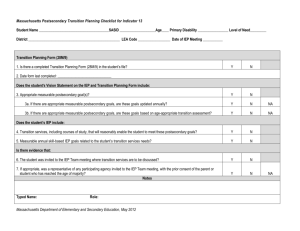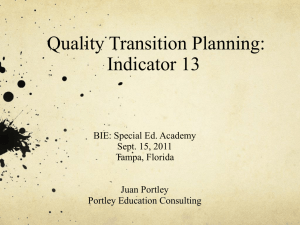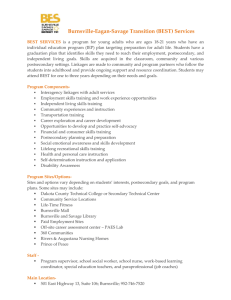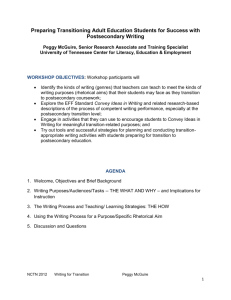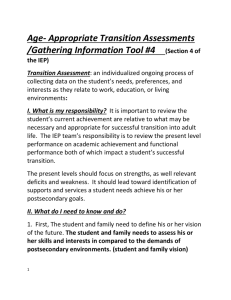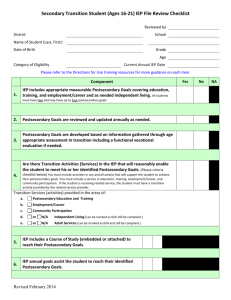Post School Outcomes
advertisement
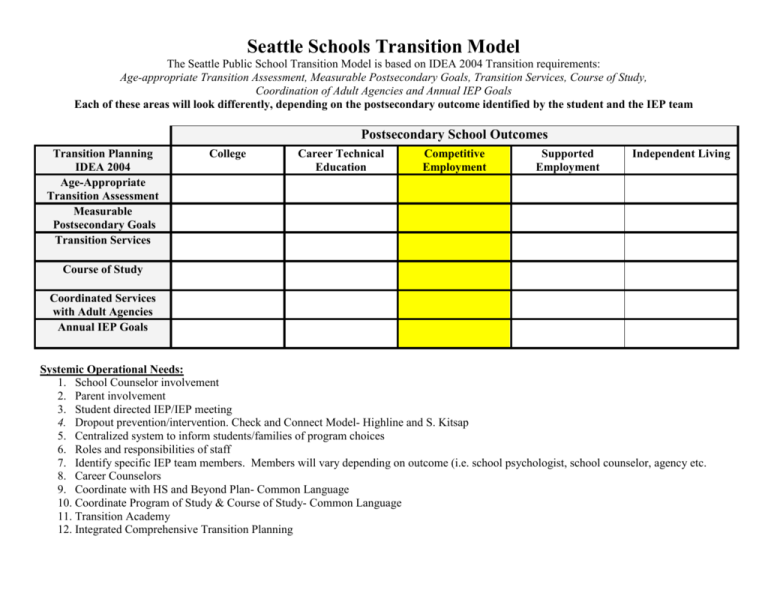
Seattle Schools Transition Model The Seattle Public School Transition Model is based on IDEA 2004 Transition requirements: Age-appropriate Transition Assessment, Measurable Postsecondary Goals, Transition Services, Course of Study, Coordination of Adult Agencies and Annual IEP Goals Each of these areas will look differently, depending on the postsecondary outcome identified by the student and the IEP team Postsecondary School Outcomes Transition Planning IDEA 2004 Age-Appropriate Transition Assessment Measurable Postsecondary Goals Transition Services College Career Technical Education Competitive Employment Supported Employment Independent Living Course of Study Coordinated Services with Adult Agencies Annual IEP Goals Systemic Operational Needs: 1. School Counselor involvement 2. Parent involvement 3. Student directed IEP/IEP meeting 4. Dropout prevention/intervention. Check and Connect Model- Highline and S. Kitsap 5. Centralized system to inform students/families of program choices 6. Roles and responsibilities of staff 7. Identify specific IEP team members. Members will vary depending on outcome (i.e. school psychologist, school counselor, agency etc. 8. Career Counselors 9. Coordinate with HS and Beyond Plan- Common Language 10. Coordinate Program of Study & Course of Study- Common Language 11. Transition Academy 12. Integrated Comprehensive Transition Planning Seattle Schools Transition Model Transition Planning IDEA 2004 Age-Appropriate Transition Assessment AATA is an ongoing process of collecting data on the individual’s interests, preferences, strengths, aptitudes and barriers, using informal and formal assessments. Sources include Formal interest or aptitude tests and/or surveys, quarterly or semester grades throughout HS, current psychological assessment data indicating areas of strength and weakness and college entrance exam scores if applying to 4 year colleges. Measurable Postsecondary Goals The student’s identified goals for after the student leaves HS, and must address postsecondary education or training, employment, and if appropriate independent living skills.. Transition Services Based on individual student’s needs, interests, preferences, strengths and aptitude. Course of Study Postsecondary Outcome(s) Identify a menu of assessments that are appropriate for the postsecondary goal of your committee. Remember that assessments should be informal and formal, reflect interests and preferences, strengths and aptitudes. Some assessments cover all, some have a more limited focus. Each goal area should include WOIS as an available assessment and how it is best used with your population. Include assessments utilized by HS psychologist, who include transition assessment as part of their annual reevaluations. See attached resource materials. Include examples and non-examples of compliant Postsecondary Goals. See attached resource materials in Transition Manual and other resources. Transition Services include: Instruction, related services, community experiences, the development A multi-year description of coursework to achieve the student’s desired post-school goals, from the student’s current to anticipated exit year. Adult Agency Linkages Agency coordination needed prior to leaving school and accessing as an adult. Measureable Annual Goals Annual IEP goals, covering what the student will accomplish during that particular school year in each identified area of service including specific transition areas. of employment and other post-school adult living objectives, and if appropriate, the acquisition of daily living skills and provision of a functional vocational evaluation. Utilizing the SPS Transition Plan Course of Study Page, identify and highlight the areas that will be common focus for students with the postsecondary goal you are working on. Utilizing the SPS Transition Plan Coordination with Outside Agencies page, identify and highlight areas that are common focus for students with the postsecondary goal you are working on. See attached resources. www.seattleu.edu/ccts/agency/agency.asp Include examples and non-examples of measurable annual goals that might be common for students with the postsecondary goal you are working on. See attached resource. Seattle Schools Transition Model Transition Planning IDEA 2004 Age-Appropriate Transition Assessment AATA is an ongoing process of collecting data on the individual’s interests, preferences, strengths, aptitudes and barriers, using informal and formal assessments. Sources include Formal interest or aptitude tests and/or surveys, quarterly or semester grades throughout HS, current psychological assessment data indicating areas of strength and weakness and college entrance exam scores if applying to 4 year colleges. Competitive Employment Note: it is the IEP team that conducts the age-appropriate transition assessment; generally, it is the school personnel who puts the assessment summary into the IEP document; the primary members of the IEP team are, but not limited to: student, parents/family, IEP Case Manager, general education teacher, building administrator; additional members may include: counselor, support staff, paraprofessional, psychologist, agency personnel. Informal assessments=interviews and questionnaires, direct observation, situational assessments, curriculum-based assessments; INFORMAL ASSESSMENTS: 1. Interviews and questionnaires: a. Conducted with a variety of individuals; b. Used to determine needs, strengths, preferences and interests relative to postsecondary goals; c. Involve gathering information about the student’s current and future resources; d. www.seattleu.edu/ccts - Transition Assessment Checklist; Needs Planning Survey; Transition Needs and Preferences Survey; Transition Survey for Parent; e. www.nsttac.org/products_and_resources/tag.aspx – The Dream Sheet; Employment-related Questionnaire; f. www.transitioncoalition.org – Planning for the Future; 2. Direct observation: a. Conducted within natural or school employment or community settings; b. Direct observation are done most times by “expert” in the environment: teachers, parents, coach, co-worker, employer, paraprofessionals, other person in a student’s natural support system; c. Includes organized collection of information for behaviors (work/home/school), task completion, work quality, work initiative, communication/social skills; d. www.seattleu.edu/ccts - Transition Information Gathering form; Worker Rating Standards, Community Work Site Evaluation. 3. Situational assessment: a. Carefully examined environments where activities normally occur (leisure, work, home, school) b. Analysis of a job situation comparing student’s skills to job requirements; c. Short-term work experience for evaluation purposes; d. www.nsttac.org/products_and_resources/tag.aspx - job accommodations source = Job Accommodation Network (www.jan.org) 4. Curriculum-based assessments: a. Designed by educators; b. Gather information about a student’s performance in a particular curriculum; c. Develops instruction for the student; d. www.nsttac.org/products_and_resources/tag.aspx Seattle Schools Transition Model FORMAL ASSESSMENTS: Types of formal assessments: [Aptitude tests] [Transition planning inventories] [Career surveys] [Self-determination assessments] [Intelligence & achievement tests] [Interest & work value inventories] [Entrance/placement exams] [Personality or preference tests] [Behavioral assessment information] 1. WOIS/Career Information System - information about Washington careers, schools and training programs www.wois.org/ 2. Center for Change in Transition Services – assessment resources www.seattleu.edu/ccts/Default.aspx?id=34032 3. NSTTAC: Age-appropriate Transition Assessment Guide - Adaptive behavior assessment, aptitude tests, interest and work value inventories, intelligence tests, achievement tests, personality or preference tests, employability tests, self-determination assessments, work-related temperament tests, transition planning inventories; www.nsttac.org/products_and_resources/tag.aspx 4. Transition Coalition Assessment reviews - Transition Planning Inventory, Work Personality Profile, AIR Self-Determination Scale, Brigance Employability Skills Inventory, Occupational Aptitude Survey & Interest Schedule (OASIS-3), SDS Career Explorer Self- Assessment and Careers http://transitioncoalition.org/transition/assessment_review/all.php 5. The Zarrow Center for Learning Enrichment: Self-determination Assessment Tools – AIR Self-determination Assessment,[ARC Self-determination Scale,[ChoiceMaker Self-determination Assessment, Field & Hoffman Self- determination Assessment; http://education.ou.edu/zarrow/?p=38 6. The Transition Coalition: Transition Assessment Data through Standardized Instruments - Examples of Standardized Tests Specifically Designed for Transition Planning with Adolescents; www.transitioncoalition.org/assessing/book01/ch2a.htm 7. National Collaborative on Workforce and Disability for Youth: Career Planning Begins with Assessment – a directory of commonly used published tests; extensive lists of formal assessments in four domains: educational, psychological/diagnostic, vocational/career, medical; Assessment listings have publisher website, target group, norming procedures, administration qualifications, reliability/validity and costs; www.ncwd-youth.info/career-planning-begins-withassessment 8. Armed Services Vocational Aptitude Battery (ASVAB): aptitude and interest assessment; practice tests available for transition assessment information gathering; www.asvabprogram.com 9. Keirsey Temperament Sorter: www.keirsey.com/ 10. Career assessments programs: WorkKeys - www.act.org/workkeys/index.html; Magellan – http://valparint.com/ 11. Workforce Training and Education Coordinating Board: Where Are You Going? Free guide to career exploration and development; contains career search, education/training opportunities; employment preparation activities; to order for classroom or for each student: call (360) 753-0892 Seattle Schools Transition Model Measurable Postsecondary Goals The student’s identified goals for after the student leaves HS, and must address postsecondary education or training, employment, and if appropriate independent living skills. 12. WorkSource Job Seeker Service of Washington: Career Bridges www.careerbridge.wa.gov; www.worksourceskc.org/seekers/resources.asp#teens; 13. Bureau of Labor Statistics : Occupational Outlook Handbook; hundreds of different types of jobs; the OOH tells you: 1) the training and education needed 2) earnings 3) expected job prospects 4) what workers do on the job 5) working conditions ; www.bls.gov/oco/ Note: postsecondary goals become more specific as the student progresses through the transition process; specificity will increase as his/her investigation/research progresses; postsecondary goals may be unrealistic at first and student will investigate the reality of his/her decision and alter the plan and goals); postsecondary goals must be addressed each year; independent living skills goal (best practice= addressed each year) is not where the student will be living after high school , rather what the student needs in daily & adult living skills to live wherever s/he determines. EXAMPLE: Health and Human Services Grade 9/10: Employment: After high school, (student) will be employed in a health profession. Ed/Training: After high school, (student) will receive on-the-job training from his/her employer. IndepLivSk: After high school, (student) will maintain personal finances independently. NON-EXAMPLES: Employment: (student) wants to work as a nurse. Ed/Training: (student) plans to get training. IndepLivSk: (student) should learn to manager his/her money. Grade 11: Employment: After high school, (student) will be employed as a CNA in a healthcare facility. Ed/Training: After high school, (student) will receive on-the-job training from his/her employer. IndepLivSk: After high school, (student) will maintain pay, checking and savings tasks independently. Grade 12: Employment: After high school, (student) will be employed as a CNA in a long-term healthcare facility. Ed/Training: After high school, (student) will receive on-going O-J-T from his/her employer. IndepLivSk: N/A. (note: student acquired adequate skill in this area and no longer needs this for postsecondary environment) EXAMPLE: Science, Engineering and Industry Grade 9/10: Employment: After completing high school, (student) will be employed in the automotive industry. Ed/Training: After graduation, (student) will receive on-the-job training from his/her employer. IndepLivSk: Not at this time. NON-EXAMPLES: Employment: (student) has aptitude in mechanics. Ed/Training: (student) can learn automotive repair. Seattle Schools Transition Model Transition Services Based on individual student’s needs, interests, preferences, strengths and aptitude. Grade 11: Employment: After high school, (student) will be employed in an auto repair position. Ed/Training: After graduation, (student) will receive on-the-job training from his/her employer. IndepLivSk: Not at this time. Grade 12: Employment: After completing high school, (student) will continue his employment in the automotive industry at Phil Smart Mercedes, Inc. (school work experience job will become fulltime). Ed/Training: After high school, (student) will receive continued training for advancement and pay grade from his/her employer. IndepLivSk: Not at this time. Note: transition services are coordinated activities in which the student will participate during the life of the current IEP; activities relate to the student’s measurable postsecondary goals; Areas of services to be considered=INSTRUCTION, RELATED SERVICES, COMMUNITY EXPERIENCES, EMPLOYMENT and ADULT and DAILY LIVING SKILLS EXAMPLE: Health and Human Services Grade 9/10: 1. Investigate careers in health professions and report; responsible=student/SE teacher 2. Reading instruction to apply, learn and maintain a job; SE teacher 3. Math instruction for better potential performance on a job; SE teacher 4. Instruction on money management; SE teacher 5. Apply for Health Sciences Occupations course for grade 11; student/SE teacher Grade 11: 1. Attend Health Sciences Occupations course; student/SE teacher 2. Conduct informational interview with a working professional in the health field; student/ SE teacher ; 3. Instruction on money management; SE teacher 4. Job shadow relative or neighbor or family friend in the health field; student/parent/ SE teacher 5. Reading instruction for better potential performance on a job; SE teacher 6. Math instruction related to personal finances and payroll; 7. Apply to the Advanced Health Sciences Occupations course for grade 12; student/SE teacher Grade 12: 1. Attend Advanced Health Sciences Occupations course; student/SE teacher 2. Reading instruction for health occupation course performance; SE teacher 3. Math instruction for health occupation course performance; SE teacher 4. Work experience in a health related position; student/SE teacher Seattle Schools Transition Model Course of Study A multi-year description of coursework to achieve the student’s desired post-school goals, from the student’s current to anticipated exit year. EXAMPLE: Science, Engineering and Industry Grade 9/10: 1. Investigate careers in automotive profession and report; responsible=student/SE teacher 2. Reading instruction to apply, learn and maintain a job; SE teacher 3. Math instruction for better potential performance on a job; SE teacher 4. Research transportation options for commuting to work; student/ SE teacher 5. Instruction on money management; SE teacher Grade 11: 1. Research 2-3 various specialties in the automotive industry and report in writing; student/SE teacher; 2. Conduct informational interview with at least 2 automotive professionals; student/ SE teacher ; 3. Job shadow relative or neighbor or family friend in automotive industry; student/parent/ SE teacher; 4. Reading instruction for auto manuals on a job; SE teacher; 5. Math instruction related auto industry; SE teacher 6. Apply for Automotive course for grade 12; student/.SE teacher; Grade 12: 1. Attend Automotive course; student/SE teacher 2. Reading instruction for auto manuals on a job; SE teacher 3. Math instruction related to auto industry; SE teacher 4. Work experience in a automotive related position; student/SE teacher Note: course of study format may be narrative by year or multi-year summary or in grid format listing all specific courses and activities the student in which the student will participate during high school. EXAMPLE: Health and Human Services Grade 9/10: (Student) will take all required courses for grade 9/10: RR English, RR math, history, science, technology, PE/art; electives will relate to postsecondary goal of health occupations; science sequence will be life sciences (general life, biology, biology skills); Optional: Graduation plan: (Student) will take the HSPE with accommodations; (student) will graduate with the standard credit format without substitutions; (student) will complete a senior project comparable to his/her peers. Grade 11: (Student) will take all required courses for grade 11: RR English, RR math, science, history, computer basics, PE/art or drama; electives include Health Sciences Occupations training course, child development or applied health; science sequence will be life sciences (general life, biology, biology skills); community experience will be a job shadow with a professional in the health sciences field. Grade 12: (Student) will take all required courses for grade 12 and graduation: RR English, RR math, senior Seattle Schools Transition Model history; (student) will attend the Advanced Health Sciences Occupations course 2 hr each day, child development, applied health or personal fitness/care; community experience will be a job shadow with a professional in the health sciences field. Adult Agency Linkages Agency coordination needed prior to leaving school and accessing as an adult. Measureable Annual Goals Annual IEP goals, covering what the student will accomplish during that particular school year in each identified area of service including specific transition areas. EXAMPLE: Science, Engineering and Industry Grade 9/10: (Student) will take all required courses for grade 9/10: RR English, RR math, history, science, technology, PE/art; electives will relate to postsecondary goal of automotive technician; math will be functional as it applies to calculation and measuring technical skills; Optional: Graduation plan: (Student) will take the HSPE with accommodations; (student) will graduate with the standard credit format with substitutions (see attached); (student) will complete a senior project comparable to his/her peers. Grade 11: (Student) will take all required courses for grade 11: RR English, RR math ( Applied Math), science, history, computer basics, PE/art or drama; electives include auto basics, 2 community lab (work experience); community experience will be 3 2-hr/day work experience in automotive: auto repair, auto body, auto service. Grade 12: (Student) will take all required courses for grade 12 and graduation: RR English, RR math (Applied Math), senior history; (student) will attend the 3-hr intradistrict automotive course; (student) will continue community work experience with current employer. Two (2) agencies are the primary potential linkages for students leaving high school and entering competitive employment: Division of Vocational Rehabilitation (DVR), WorkSource. DVR: About DVR - www.dshs.wa.gov/DVR/About/aboutdvr.aspx Office Locations - www.dshs.wa.gov/DVR/ContactUs/DVROffices.aspx High School Liaison list - www.dshs.wa.gov/dvr/QuickLinks/SchoolTransition/Transition.aspx WorkSource: What is WorkSource - https://fortress.wa.gov/esd/worksource/Employment.aspx WorkSource locations - http://www.wa.gov/esd/wsdirectory_local.htm#kingwda Note: Measurable annual goals contain four critical elements: timeframe, conditions, behavior, criterion EXAMPLE: Health and Human Services 1. Given material related to health services, (student) will increase reading from ___ to ____ as measured by _____ by (June) 20___ 2. Given internet occupation searches, (student) will increase written expression in sentence construction by presenting occupation/career search results in writing with 80% accurate sentence structure by (May ) 20__ as measured by teacher evaluation. 3. Given money management curriculum, (student) will increase his/her ability to maintain a checkbook Seattle Schools Transition Model and bill payments with 80% as measured by ___________ by (May) 20__. 4. Given instruction in conducting informational interviews, (student) will complete one informational interview with a healthcare professional with 90% accuracy as measured by teacher by (May) 20_ _. EXAMPLE: Science, Engineering and Industry 1. Given a technical manual, (student) will increase reading comprehension from ___ to ___ as measured by _____ by (June) 20___ 2. Given access to internet and the Occupational Outlook Handbook, (student) will increase his/her knowledge of career specialties within the automotive industry from ___ to ___ as measured by teacher evaluation by (June) 20__. 3. Given functional math related to mechanics, (student) will increase his/her knowledge of liquid measurement from ___% to ____% as measured by _______ math curriculum by (May) 20___.

